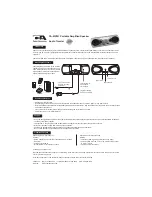
Page
bit of asymmetry here is actually preferable.
Symmetrical
placement generally results in
larger
standing waves
in the room that reinforce certain frequencies and diminish others.
When you take the time to place your speakers properly, you’ll realize better “imaging”
(the apparent lateral placement of individual instruments or voices), and more depth or
“layering”. You’ll hear those advantages because you’ll be avoiding the aural confusion
caused by so-called “first reflections” that complicate our perceptions when speakers are
too close to a wall’s large, flat, reflecting surface.
Is placement of a tower speaker different than a monitor?
Generally speaking, the same rules for monitors on a stand apply to tower speakers,
however the AV123 x-pls 3-way D’Appolito tower with the integrated powered subwoofer
creates some interesting exceptions and trade-offs.
First, the x-pls towers are a “mirrored” design which allows placement as left and right
speakers to have the passive radiator facing on the outside or inside depending on the
situation. If they are used in a smaller room, face the passive radiators in (toward one
another); if they are used in a larger room, face the passive radiators out (toward the
wall). Experiment with what works best for you.
The second consideration is of course the proximity to the nearest walls. You can place
the x-pls towers relatively close to walls for the benefit of the passive radiator with
the “boundary effect”, but of course that will cause issues with the 2-way portion of
the speaker due to reflections off of that wall. It is best to experiment with the passive
radiator location relative to the walls. The above consideration must be taken into
account in addition to the previous recommendations made for
the monitor speakers and other passive towers.
Should I “Toe In” the front speakers?
That’s a question many enthusiasts ask us at AV123. Some
people like to “toe-in” their main speakers to get better
performance. This simply means aiming both Left and Right
speakers so that they point more towards the prime listening/
viewing position rather than straight ahead. “Toe-in” can
improve imaging and add a sense of spaciousness to the
sound. In a 2-channel system (with no discrete center channel
Back Wall of Room
1/3
Primary Listening Position
Primary Listening Position
LEFT
RIGHT
Minimum of 3”
from Wall
2/3
Maintain the
same distance
to the listener
Back Wall of Room
1/3
Primary Listening Position
Primary Listening Position
LEFT
RIGHT
2/3
NOT
RECOMMENDED!
Placement in rooms with
odd shaped back walls
should still align the
speaker distances equally
to the listening position.
Don’t rely on electronic
time delay correction to fix
these problems whenever
possible as the difference
in room shape cannot
always be accounted for
with a straight time delay.
“Toe In” of Left and Right Speakers
Primary Listening Position
Primary Listening Position
LEFT
RIGHT
Summary of Contents for x-cs
Page 1: ...x series Enjoyment Guide...
Page 23: ...Page 23 USER NOTES...










































